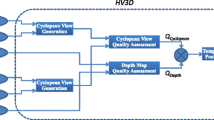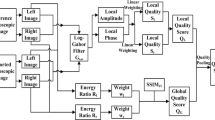Abstract
Stereoscopic video create the impression of depth by using two slightly different viewpoints. Conventional video quality assessment methods for 2D video are not suitable for stereoscopic video, so a new video quality assessment model for stereoscopic video is needed. In this paper, we propose a new objective video quality metric for compressed stereoscopic video. The proposed algorithm uses blocking artifacts, blurring in edge regions and video quality difference between two views. Blocking artifacts and blurring in edge regions are distortion appeared in the compressed video, and they are widely used in conventional video quality model. Difference in video quality between two views considers 3D effect of stereoscopic video. To verify the performance of the proposed algorithm, we performed subjective evaluation of stereoscopic video, and we confirmed that the proposed algorithm is superior to the conventional algorithms in respect to correlation with the subjective evaluation.
Similar content being viewed by others
References
A. Benoit, P.L. Callet, P. Campisi, R. Cousseau, Quality assessment of stereoscopic images, EURASIP J. Image Video Process. doi:10.1155/2008/659024 (2008)
P. Campisi, P.L. Callet, E. Marini, Stereoscopic images quality assessment, in Proc. 15th European Signal Processing Conference (EUSIPCO) (2007)
M. Carnec, P. Le Callet, D. Barba, An image quality assessment method based on perception of structural information, in Proc. of IEEE Int. Conf. on Image Process, ICIP 2003, vol. 3 (2003), pp. 185–188
G. Chen, C. Yang, S. Xie, Gradient-based structural similarity for image quality assessment, in Proc. of IEEE Int. Conf. on Image Process, ICIP 2006 (2006), pp. 2929–2932
G. Chen, C. Yang, L. Po, S. Xie, Edge-based structural similarity for image quality assessment, in Proc. International Conference on Acoustics, Speech and Signal Processing, vol. II (2006), pp. 933–936
International Telecommunication Union, Objective perceptual video quality measurement techniques for digital cable television in the presence of a full reference. ITU-T Recomm. J. 144 (2004)
International Telecommunication Union, Perceptual visual quality measurement techniques for multimedia services over digital cable television networks in the presence of a reduced bandwidth reference. ITU-T Recomm. J. 246 (2008)
International Telecommunication Union, Objective perceptual multimedia video quality measurement in the presence of a full reference. ITU-T Recomm. J. 247 (2008)
International Telecommunication Union, Subjective video quality assessment methods for multimedia applications. ITU-T Recomm. P. 910 (1999)
ISO/IEC JTC1 WG11 MPEG, Text of ISO/IEC 14496-10:200X/FDAM 1 Multi-view Video Coding, w9978 (2008)
A. Khan, S. Lingfen, E. Ifeachor, An ANFIS-based hybrid video quality prediction model for video streaming over wireless networks, in Proc. of Next Generation Mobile Appl., Services and Technol. (2008), pp. 357–362
T. Kusuma, H. Zepernick, M. Caldera, On the development of a reduced-reference perceptual image quality metric, in Proc. of the 2005 Systems Commun. (2005), pp. 178–184
C. Lee, S. Cho, J. Choe, T. Jung, W. Ahn, Edge degradation for objective video quality metrics, in Proc. of SPIE and IS&T Electronic Imaging, vol. 5308 (2004), pp. 1253–1260
C. Lee, S. Cho, J. Choe, T. Jeong, W. Ahn, E. Lee, Objective video quality assessment. Opt. Eng. 45(1), 017004 (2006), 11 pp.
D. Min, K. Sohn, Cost aggregation and occlusion handling with WLS in stereo matching. IEEE Trans. Image Process. 17(8), 1431–1442 (2008)
S. Pastoor, M. Wopking, 3-D displays: a review of current technologies. Displays 17(2), 100–110 (1997)
M. Pinson, S. Wolf, A new standardized method for objectively measuring video quality. IEEE Trans. Broadcast. 50(3), 312–322 (2004)
A. Puri, R. Kollarits, B. Haskell, Basics of stereoscopic video, new compression results with MPEG-2 and a proposal for MPEG-4. Signal Process Image Commun. 10(1–3), 201–234 (1997)
D. Scharstein, R. Szeliski, A taxonomy and evaluation of dense two-frame stereo correspondence algorithms. Int. J. Comput. Vis. 47(1–3), 7–42 (2002)
L. Stelmach, W. Tam, Stereoscopic image coding: effect of disparate image-quality in left- and right-eye views. Signal Process. Image Commun. 14(1–2), 111–117 (1998)
H. Tong, M. Li, H. Zhang, C. Zhang, Blur detection for digital images using wavelet transform, in Proc. of IEEE Int. Conf. on Multimed. & Expo (2004), pp. 17–20
G. Triantafyllidis, D. Tzovaras, M. Strintzis, Blocking artifact detection and reduction in compressed data. IEEE Trans. Circuits Syst. Video Technol. 12(10), 877–890 (2002)
D. Turaga, Y. Chen, J. Caviedes, No reference PSNR estimation for compressed pictures. Signal Process. Image Commun. 19(2), 173–184 (2004)
Z. Wang, A. Bovik, Modern Image Quality Assessment (Morgan & Claypool, 2006)
Z. Wang, A. Bovik, Mean squared error: love it or leave it? a new look at signal fidelity measures. IEEE Signal Process. Mag. 26(1), 98–117 (2009)
Z. Wang, A. Bovik, H. Sheikh, E. Simoncelli, Image quality assessment: from error visibility to structural similarity. IEEE Trans. Image Process. 13(4), 600–612 (2004)
Z. Wang, E. Simoncelli, A. Bovik, Multi-scale structural similarity for image quality assessment, in Proc. of IEEE Asilomar Conf. on Signals, Syst., and Comput., vol. 2 (2003), pp. 1398–1402
Z. Wang, E. Simoncelli, Translation insensitive image similarity in complex wavelet domain, in IEEE Int. Conf. on Acoust., Speech, & Signal Process., vol. 2 (2005), pp. 573–576
Author information
Authors and Affiliations
Corresponding author
Rights and permissions
About this article
Cite this article
Seo, J., Liu, X., Kim, D. et al. An Objective Video Quality Metric for Compressed Stereoscopic Video. Circuits Syst Signal Process 31, 1089–1107 (2012). https://doi.org/10.1007/s00034-011-9369-7
Received:
Revised:
Published:
Issue Date:
DOI: https://doi.org/10.1007/s00034-011-9369-7




